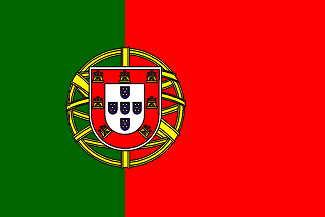 |
 |
part 1 |
Saturday 4 September 2021
We get up at 4.25 am and go to the airport. After checking in for the
flight with TAP
Portugal to Lisbon, we have breakfast at Schiphol. The flight to
Lisbon leaves 15 minutes early at 6.45 am and arrives at Lisbon Airport
in plenty of time. In Lisbon we have to take a bus to the terminal.
There our QR code is checked for the vaccination against Corona. After
that we get in the wrong line, but that is quickly resolved. We eat
something in the food court and then wait for the flight to Terceira.
Here too we are the first to board because we have premium boarding on
our ticket.
This flight is also going well. We now have a little more legroom than
on the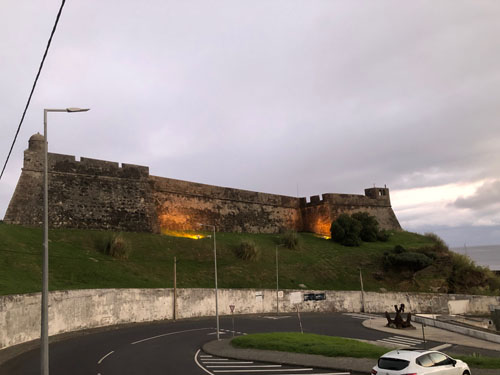 first flight. That first flight
was disappointing, because, even though we had exit row seats, we hardly
had any extra legroom. We land around 12.55 local time (two hours
earlier than NL). We pick up our rental car at Ilha Verde. That takes quite some time, but after
a lot of patience we get a white Renault Clio. We drive to Angra do
Heroismo, to the Pousada. Our room has a sea view, but is a bit
dated. We cannot eat in the restaurant in the evening because there is a
wedding. Lunch is not served here anyway. That is disappointing.
first flight. That first flight
was disappointing, because, even though we had exit row seats, we hardly
had any extra legroom. We land around 12.55 local time (two hours
earlier than NL). We pick up our rental car at Ilha Verde. That takes quite some time, but after
a lot of patience we get a white Renault Clio. We drive to Angra do
Heroismo, to the Pousada. Our room has a sea view, but is a bit
dated. We cannot eat in the restaurant in the evening because there is a
wedding. Lunch is not served here anyway. That is disappointing.
We go downtown for lunch at Tasca de Tias and that's fine. In the evening we
have to go out again for dinner. We call around a bit, but is is not
easy. Many restaurants are fully booked. Eventually we find a
steakhouse, where we can go. Simple, but fine and friendly service. Erik
takes a pepper steak and I take the sea bass. That fish is served on a
red-hot stone and has to grill a bit on the table.
Back in the hotel we watch the replay of the international football
match (Netherlands-Montenegro) and then we fall asleep like a log.
Weather: 23 degrees and cloudy. Sometimes some rain.
Sunday 5 September 2021
We sleep until 7.30 am and have breakfast in the hotel. The breakfast
buffet is very good and has a large choice. After breakfast we go by car
for a tour of the island. We drive through the middle to the north. It
rains intermittently, but there are certainly dry periods as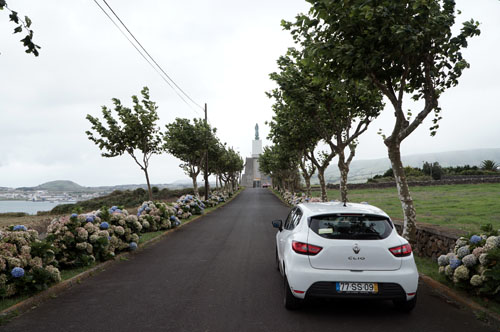 well. At the Furnas do
Enxofre we get out of the car to view the geothermal landscape. However,
it starts to rain violently and horizontally, so we end the walk on the
marked trail prematurely. We continue to Praia de Vittoria on the east
coast. Here it is dry again. We walk around the (seaside) town before we
drive on to the Serra do Cume, a ridge of more than 500 meters above sea
level. From a miradouro we have a beautiful view over the island. We
meet a male couple from Groningen. They are also traveling through the
archipelago, but have only one day left. They think Terceira is the
flattest island so far, so that's promising! We drive back to Angra and
have quite a bit of trouble finding a place for lunch. Many businesses
are closed on Sundays. We find something at the harbour, but the quality
is n
well. At the Furnas do
Enxofre we get out of the car to view the geothermal landscape. However,
it starts to rain violently and horizontally, so we end the walk on the
marked trail prematurely. We continue to Praia de Vittoria on the east
coast. Here it is dry again. We walk around the (seaside) town before we
drive on to the Serra do Cume, a ridge of more than 500 meters above sea
level. From a miradouro we have a beautiful view over the island. We
meet a male couple from Groningen. They are also traveling through the
archipelago, but have only one day left. They think Terceira is the
flattest island so far, so that's promising! We drive back to Angra and
have quite a bit of trouble finding a place for lunch. Many businesses
are closed on Sundays. We find something at the harbour, but the quality
is n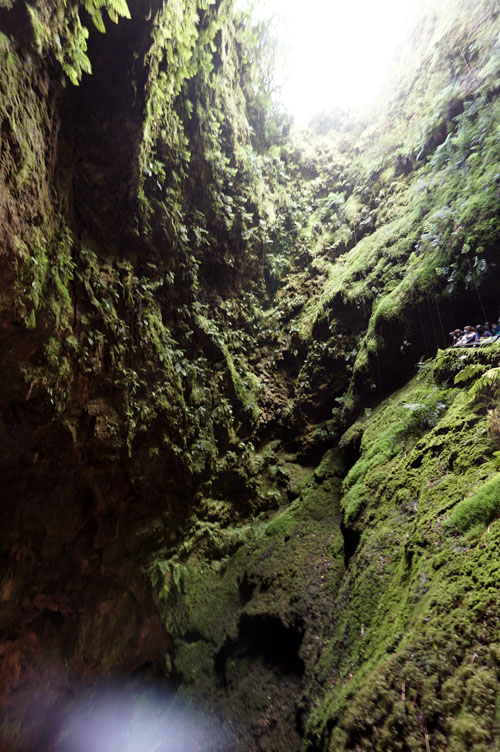 ot
really good. After lunch we rest for a while in the room in the Pousada,
which is located in a 16th century fortress.
ot
really good. After lunch we rest for a while in the room in the Pousada,
which is located in a 16th century fortress.
After the siesta, we drive to the Gruta de Natal. This is a cave formed by underground lava flows. Our underground route is difficult and the passages are often narrow and low. It is beautiful, but it takes a lot of effort. The entrance fee includes a visit to another cave, the Algar de Corvão. This is an empty volcanic cone. You enter the volcano through a concrete tunnel. The space is huge. There is a hole at the top, the volcano hole and the walls are overgrown with mosses and ferns. Water is constantly dripping down. Concrete stairs have been constructed in the volcano by which you can go down into the volcano. It is an impressive experience.
We drive back to th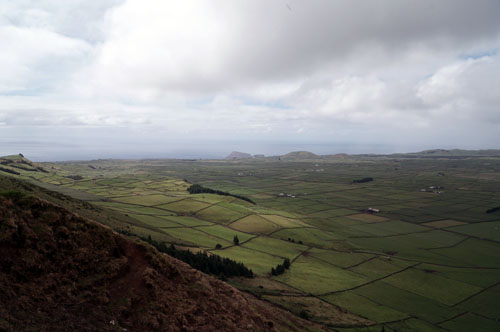 e
Pousada and drink a glass of wine in the hotel bar. A cocktail doesn't
work out, because the staff doesn't know how to make them. Another
setback. After our order, we are left to our own devices. In the evening
we eat in the hotel restaurant. We have also better in a Pousada. The
food is mediocre. It's not expensive either, so it's good value for
money. The wait staff is a bit inept and does not know the wine list.
Erik takes a veal medallion as main course and I a trio of meat. Nice,
but not shocking. The dessert is the best psrt of the meal.
e
Pousada and drink a glass of wine in the hotel bar. A cocktail doesn't
work out, because the staff doesn't know how to make them. Another
setback. After our order, we are left to our own devices. In the evening
we eat in the hotel restaurant. We have also better in a Pousada. The
food is mediocre. It's not expensive either, so it's good value for
money. The wait staff is a bit inept and does not know the wine list.
Erik takes a veal medallion as main course and I a trio of meat. Nice,
but not shocking. The dessert is the best psrt of the meal.
Weather: very changeable. Showers and sunny periods. 18-23 degrees.
Monday 6 September 2021
After breakfast we dr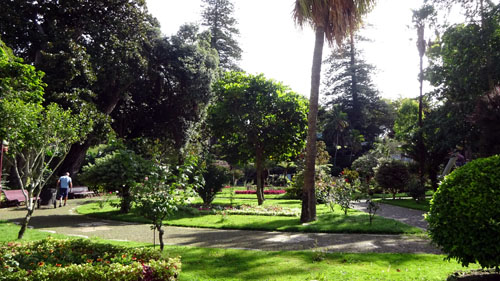 ive to the center of Angra. We
take a walk through the center. We pass the Misericordia Church, the
Cathedral and the former Palace of the Captains General (Governor). The
walk ends in the park of De Duque de Terceira, an 18th century
landscaped park, designed by a Belgian landscape gardener, who emigrated
from Liège to the Azores when he was only 18. From the park I climb a
hill and am rewarded by a beautiful view of Angra and the Mont Brasil.
Just like King Pedro IV had, who climbed up here in 1846 and who is now
honored with an obelisk at the top. Back downstairs we have a soft drink
on a terrace before we drive the car west for a trip along the coast. In
Sao Mateo de Colheta we enjoy the view of the fishing port. In Cinco
Ribeiro the cheese factory is open, but here you can only taste and eat
a cheese sandwich. It continues
ive to the center of Angra. We
take a walk through the center. We pass the Misericordia Church, the
Cathedral and the former Palace of the Captains General (Governor). The
walk ends in the park of De Duque de Terceira, an 18th century
landscaped park, designed by a Belgian landscape gardener, who emigrated
from Liège to the Azores when he was only 18. From the park I climb a
hill and am rewarded by a beautiful view of Angra and the Mont Brasil.
Just like King Pedro IV had, who climbed up here in 1846 and who is now
honored with an obelisk at the top. Back downstairs we have a soft drink
on a terrace before we drive the car west for a trip along the coast. In
Sao Mateo de Colheta we enjoy the view of the fishing port. In Cinco
Ribeiro the cheese factory is open, but here you can only taste and eat
a cheese sandwich. It continues  to Santa
Barbera, where we take the road up to the Serra Barbara. However, it is
too cloudy and foggy to enjoy the view. We drive on to Rominho, where
there is a nice viewpoint. The road continues north to Biscoito. This is
the center of Terceira's viticulture, but unfortunately the wine museum
is closed on Mondays. We can eat at Ti Pedro, where the wait staff is
somewhat overwhelmed. It takes at least three quarters of an hour before
we have something to eat. After lunch we drive back to Angra. We rest
and then have a drink from the hotel bar and enjoy it on the terrace. In
the evening we eat at Tasca das Tias, where we had lunch earlier. The
food is tasty and the service is smooth. Afterwards we walk back to the
hotel. A walk over steep slopes that takes a little over fifteen
minutes.
to Santa
Barbera, where we take the road up to the Serra Barbara. However, it is
too cloudy and foggy to enjoy the view. We drive on to Rominho, where
there is a nice viewpoint. The road continues north to Biscoito. This is
the center of Terceira's viticulture, but unfortunately the wine museum
is closed on Mondays. We can eat at Ti Pedro, where the wait staff is
somewhat overwhelmed. It takes at least three quarters of an hour before
we have something to eat. After lunch we drive back to Angra. We rest
and then have a drink from the hotel bar and enjoy it on the terrace. In
the evening we eat at Tasca das Tias, where we had lunch earlier. The
food is tasty and the service is smooth. Afterwards we walk back to the
hotel. A walk over steep slopes that takes a little over fifteen
minutes.
Weather: very changeable, from sunny and warm to rainy and fresh. 17-23
degrees
Tuesday 7 september 2021
We get up early and have breakfast before 7:30 am. After breakfast we
head for the airport. We return the car and check in for the flight. We
are  way too early and
have to wait another hour and a half before we can board. The flight
with SATA
Azores Airlines takes more than 20 minutes to the island of Pico,
where we arrive just before eleven o'clock. We rent a car here again
from Ilha Verde. This time a Ford Focus (diesel). We drive to the
Bed&Breakfast Calmo
do Mar in Madalena. Petra welcomes us and explains everything. We
rest for a while and then head for Mount Pico. The weather is
exceptionally clear and therefore ideally suited to enjoy the view from
over 900 meters above sea level. It's beautiful. The sun is shining and
the sky is blue. We can clearly see the neighboring islands of Faial and
São Jorge. Pico is a resting volcano and with more than 2,300 meters the
highest mountain in Portugal. He can be seen from afar.
way too early and
have to wait another hour and a half before we can board. The flight
with SATA
Azores Airlines takes more than 20 minutes to the island of Pico,
where we arrive just before eleven o'clock. We rent a car here again
from Ilha Verde. This time a Ford Focus (diesel). We drive to the
Bed&Breakfast Calmo
do Mar in Madalena. Petra welcomes us and explains everything. We
rest for a while and then head for Mount Pico. The weather is
exceptionally clear and therefore ideally suited to enjoy the view from
over 900 meters above sea level. It's beautiful. The sun is shining and
the sky is blue. We can clearly see the neighboring islands of Faial and
São Jorge. Pico is a resting volcano and with more than 2,300 meters the
highest mountain in Portugal. He can be seen from afar.
Back down in Madalena we have lunch at Cafe Cinq. It's a busy place, but
the food tastes good. After lunch return to the B&B for a rest. Then
we drive to a 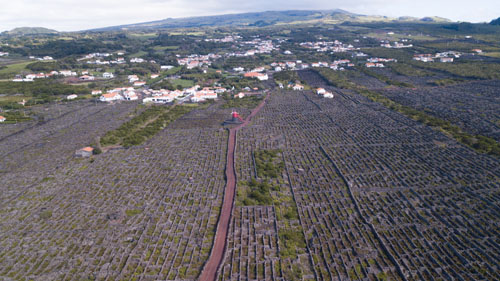 hypermarket for some groceries
and from there to the Moinho do Frade, an old windmill in a vineyard.
The mill is a UNESCO World Heritage Site. During this time the grape
harvest is being brought in. I let the drone fly around for shots of the
vineyard, which is compartmented by lava rock walls.
hypermarket for some groceries
and from there to the Moinho do Frade, an old windmill in a vineyard.
The mill is a UNESCO World Heritage Site. During this time the grape
harvest is being brought in. I let the drone fly around for shots of the
vineyard, which is compartmented by lava rock walls.
We go back to the B&B, drink a beer and then walk to the restaurant
O Ancoradouro.
A lovely restaurant with terrace on the shore of the strait between Pico
and Faial with a view of Horta, the main town of Faial. I eat Octopus
and Erik pepper steak, accompanied by a Verdelho wine from the island
itself.
Weather: sunny, 24°C
Wednesday 8 September 2021
We have breakfast 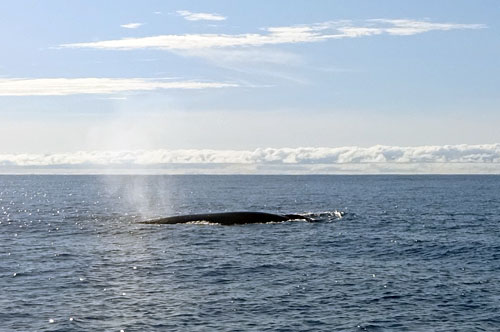 around 7:30 am and then go by car
to Lajes de Pico, a harbour town on the south coast of the island.
There we booked a whale watching tour from Espaço Talasso. The tour starts at 9 am. Soon we
get to see common dolphins swimming and jumping around our boat. Then we
sail a long way out to sea and see a couple of sei whales. Rare at this
time of year, as these fin whales usually prey on krill, which only
lives in cold water. However, there are some sei whales, which can also
live on fish. It is still quite difficult to get a picture of these huge
animals, because when you see them they have already disappeared in the
water. They are large animals, growing up to 12 to 18 meters in length.
Only the blue and fin whales are larger. The sei whale is a fast swimmer
and very agile. It reaches speeds of 55 km/h. That makes him hard to
follow. It often and quickly changes direction. They only stay above
water for a short time and then dive back down. They do not raise the
tail, as the sperm whales do. Our guide puts the hydrophone in the water
to listen for sperm whales, but unfortunately they are not around. We
around 7:30 am and then go by car
to Lajes de Pico, a harbour town on the south coast of the island.
There we booked a whale watching tour from Espaço Talasso. The tour starts at 9 am. Soon we
get to see common dolphins swimming and jumping around our boat. Then we
sail a long way out to sea and see a couple of sei whales. Rare at this
time of year, as these fin whales usually prey on krill, which only
lives in cold water. However, there are some sei whales, which can also
live on fish. It is still quite difficult to get a picture of these huge
animals, because when you see them they have already disappeared in the
water. They are large animals, growing up to 12 to 18 meters in length.
Only the blue and fin whales are larger. The sei whale is a fast swimmer
and very agile. It reaches speeds of 55 km/h. That makes him hard to
follow. It often and quickly changes direction. They only stay above
water for a short time and then dive back down. They do not raise the
tail, as the sperm whales do. Our guide puts the hydrophone in the water
to listen for sperm whales, but unfortunately they are not around. We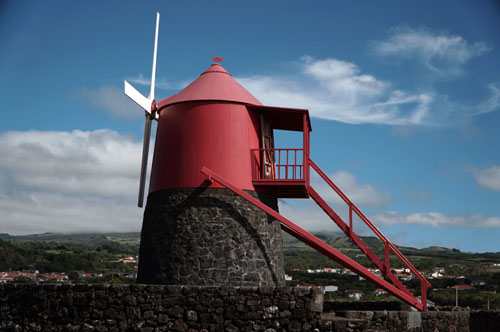 therefore sail on and meet a group of
bottlenose dolphins. These are lively and cheerful animals that jump and
dive around the boat. Finally, closer to shore, we encounter a group of
gray dolphins or Risso's dolphins or Grampers. These have a blunt nose
and high pointed dorsal fin and are gray to white. They become whiter
with scars they incur in mutual fights.
therefore sail on and meet a group of
bottlenose dolphins. These are lively and cheerful animals that jump and
dive around the boat. Finally, closer to shore, we encounter a group of
gray dolphins or Risso's dolphins or Grampers. These have a blunt nose
and high pointed dorsal fin and are gray to white. They become whiter
with scars they incur in mutual fights.
Then the trip is over and we sail into the harbour. We have lunch at the
harbour and then go on a tour of the east coast of the island. We stop
in Calhete de Nesquim, where we have a look at the church and drink
coffee. Then continue to the Ponta del Ilha lighthouse. Looks good, but
nothing special. We drive on to the North Coast and stop at a miradouro
of Terra Alta. Then we take the coastal road via Santa Armaro and
Prainha back to the main road to Sao Roque. We then take a small
mountain road as a shortcut to the main road that leads across the
center of the island to Madalena. We drink a glass of wine in the garden
of our B&B and in the evening we eat at Tasca O Petisca. Nice restaurant. Too bad my steak
was rather tough.
Weather: sunny day with occasional clouds. 24 degrees
Thursday 9 september 2021
We start the day with a cup of coffee in 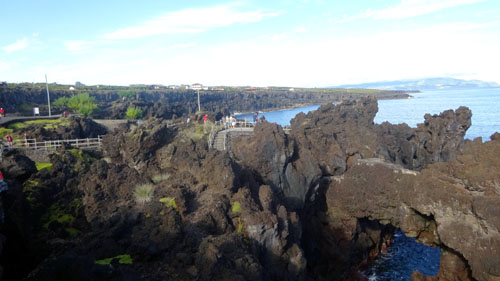 the center of
Madalena. Then we drive along the north coast to Cachorro, where there
is a beautiful viewpoint on the lava coast, overlooking the neighboring
island of São Jorge. We continue along the north coast and stop once
more in Arcos and later again at Santo Antonio. Then we drive on to São
Roque de Pico, where we do a walk. The walk runs along a dried up stream
uphill past a number of water mills. Then the route goes horizontal for
a while (first in the wrong direction) before going back to Sao Roque
along another stream. The walk is known as “easy”, but the path goes
over difficult rocky patches here and there.
the center of
Madalena. Then we drive along the north coast to Cachorro, where there
is a beautiful viewpoint on the lava coast, overlooking the neighboring
island of São Jorge. We continue along the north coast and stop once
more in Arcos and later again at Santo Antonio. Then we drive on to São
Roque de Pico, where we do a walk. The walk runs along a dried up stream
uphill past a number of water mills. Then the route goes horizontal for
a while (first in the wrong direction) before going back to Sao Roque
along another stream. The walk is known as “easy”, but the path goes
over difficult rocky patches here and there.
We have lunch in Sao Roque at Casa Ancora. Surprisingly modern and good dishes
with a sea view. Then we go inland again to 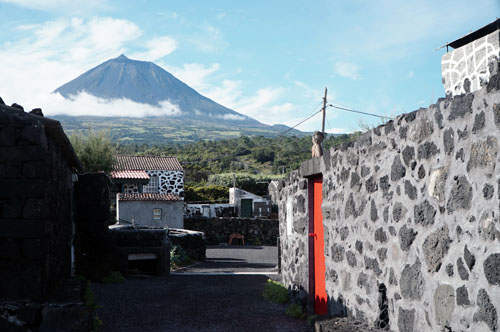 the Lagoa de Capitão, a
mountain lake at a few hundred meters altitude. We continue to Lajes on
the south coast, where we did the whale watching tour yesterday, then
head west again along the coast to Madalena. Along the way we see some
typical red windmills, which belong to the UNESCO World Heritage.
the Lagoa de Capitão, a
mountain lake at a few hundred meters altitude. We continue to Lajes on
the south coast, where we did the whale watching tour yesterday, then
head west again along the coast to Madalena. Along the way we see some
typical red windmills, which belong to the UNESCO World Heritage.
In the evening we drink a cocktail at the Recycle Bar and afterwards we eat at restaurant /
pub Arruda a simple eatery for the locals without any frills. The food
is excellent however, and the service friendly. When making a
reservation by phone, I first got on the line with someone who only
spoke Portuguese. I hung up, but was called back moments later by
someone who spoke English. How nice is that?
 |
Other Travel |  |
| back | continue |